Here’s a tidy 1965 Triumph that’s also a highly desirable model, the IRS, a classic TR4 with independent rear suspension. It can be found here on eBay in North Las Vegas, Nevada with a current bid of around $13,000.
Not much information is provided on the 1965 Triumph TR4A’s provenance, though it’s “an original” (whatever that means), is drivable, and has been in the current ownership for more than five years.
What we see certainly looks promising, with no obvious flaws. Other than it being in running condition, we don’t know the condition of the drivetrain. But the interior (which looks gorgeous, down to the shiny polished wood dashboard) was done three years ago, and the paint is seven years old. “All lights and turn signals work,” and there are no dents. Does it make you nervous, as it does me when sellers refer to a car’s good “breaks”?
The TR4 was designed by the famous Giovanni Michelotti in Italy, but it’s a pure British sports car representing a natural evolution from the TR3. The TR4 was sold from 1961 to 1965, with 40,253 built (and mostly sold in the U.S.). That makes it not as successful as the TR3, which sold 74,800. But it was a considerable advance, with roll-up windows in place of those antique side curtains.
Power was from an updated Standard engine as used in the TR3, but with 2.1 liters instead of 1.9. The TR4 also got synchromesh on all four forward gears, and rack and pinion steering. A Laycock de Normanville overdrive was optional. A top speed of 110 mph was possible. It helped that the car weighed only 2,128 pounds.
The TR4A was new for 1965, and 75 percent of them were IRS models, with rear suspension that used semi-trailing arms, coil springs, and Britain’s beloved lever-arm shock absorbers. Ride comfort was said to have been improved. The mostly unchanged engine now produced 105 horsepower. The TR4A was slightly wider and got a new hood badge and a slightly revised grille, plus some new chrome trim. The walnut dash, once an option, became standard. It seems a lot of work for a car that quickly went out of production. Up next was the TR5, known in these parts as the TR 250 (with 2.5-liter six-cylinder power). Same basic body, bigger engine making 150 horsepower.
It’s funny to see how much options cost back in the 60s. Wire wheels were just £36, and overdrive could be had for £51. Although it gets cold in Britain, the heater was another £13. The cars sold in the U.S. for about $2,500.
The new owner will have lots of fun with this car. It’s hard to imagine a downside, other than Lucas electrics, if the price doesn’t go too much higher.




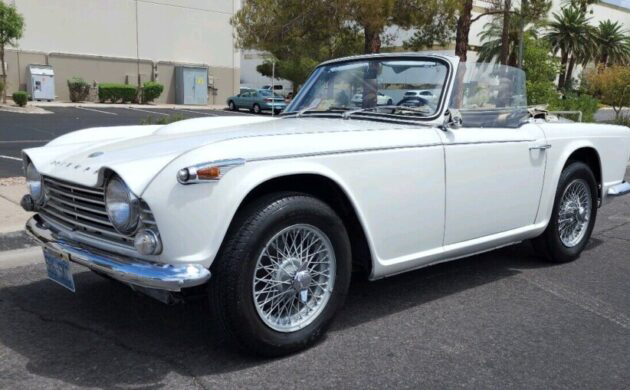
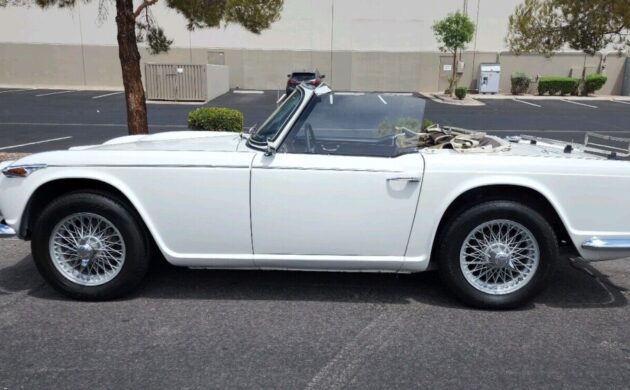


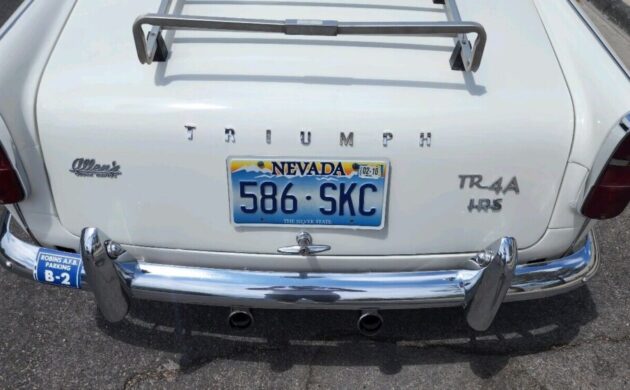

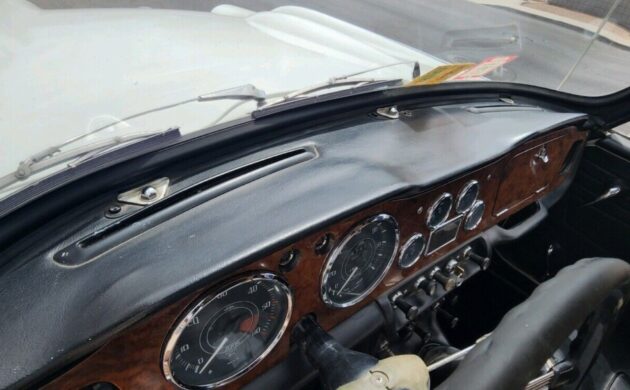
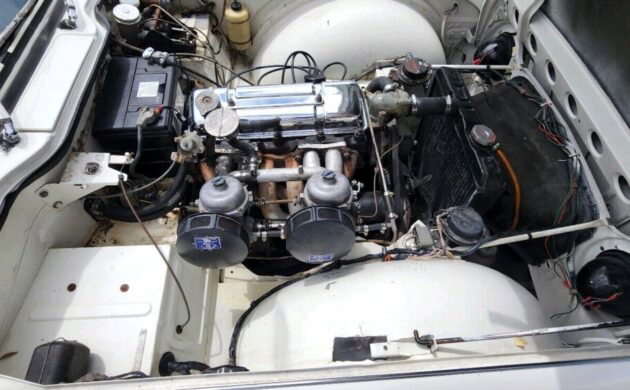



It actually looks pretty darn good.
Nice!
I don’t understand why the British cars that were imported to America seem to have given buyers so much electrical problems. The Prince of Darkness in America. I have owned many, many English cars and have never had a serious electical problem with any of them. Apart from the occaisional blown headlight bulb, SU petrol pump, and a generator or two, they were fine. Could it be that export to US models had a different system to the ones we got in Africa?
It can get extremely hot in many parts of the Mid-West and that did a lot of them in but it is more the combination of high heat in the summer and very cold of the winter that did the most damage. The rubber insulation just could not handle it. We used TEFLON insulation like today and that was much better and long lasting. I paid my way thru university years by buying old Healey’s, MG’s and Triumph’s with bad wiring harnesses and pulling them totally out, replacing them getting the carb’s balanced and selling them for up to 5 times or more what I was paid in some cases to haul them off.
WHAT A SCAM IT WAS. But I took cars from people that had no idea what they had or how to fix them and turned them into real cars again and it only took a couple of weeks to do one. Then polish, clean, and wax and you had a very good car that looked almost like new. That work is part of the reason I graduated with no college debt. I hope that answers your question.
I have to agree with your thoughts on Luvas electric systems. Having had Austin Minis, Triumphs, Rileys, Morris Minor and 23 MGBs, electrical problems have never been an issue. Any issues I had were due to previous owners “improving” things. Same with SU carburetors. Mostly of a case of “if you don’t know what you are doing, leave it alone”.
I had one exactly like this but in British Racing Green and I believe they continued to make this besides the TR-250 until 1967 which was the year of mine. I have had TR-3’s, I grew up on a 1600MK II MGA, Austin Healey’s from 100/6 to a 3000 MK III and this was one of the better ones. The Heater really worked well with that front of the windshield air vent. The windows were also a big help. The top was a bit of a pain to put up but worked well. The doors were a little rattle prone but with the exception of the 3000 MK III Healey this was the most comfortable to drive any distance. At least your tennis shoes did not melt in the summer heat like on the Healey’s. LOL I mean it I had a set that really did melt on the heals.
They tend to be rust prone on the exterior fenders and sills but panels are available and the very simple construction of the bodies makes repairing one a bit of a pain to do but very possible for a reasonable price.
This car represents what all auto makes have fled from in recent years a simple practical car that does a simple job very very well. The engines were robust as were the transmissions and I had one with the overdrive and that is a very worthy option if you are going from city to city. The electrics were more a problem of the wiring which at the time was rubber insulated and did not stand up to the HEAT of American summers. The rest was not that bad if you kept track of the various points that would wear out over time.
The real pain is the rust that is possible on the frame. That is also repairable but it take a near total restoration to do it. It takes an expert welder that will take his time to get it right. Not an easy job. That is one of the very few down points of this design.
But all that being said a fall early morning drive with the top down, the windows up, the tonneau cover on the passengers side is a joy to behold. Put the heater on full blast and let the air flow pull all of the heat over your body and only the tips of your ears will get cold and really not that cold. If you live in the country the sound of the exhaust is just loud enough and sounds good too. Simple, Sturdy, Economical with Surprising Comfort for such a small car. Very hard to beat. In some ways the TR-6 which is a fine machine in it’s own right is not quiet as sweet. Just a shade heaver to handle but that is another horse and another time.
I loved mine and the lady who did not know what side mirrors are for pinned me between her huge Buick and a concrete bridge railing at about 35 Miles per hour. The car was narrowed by about 6″. I got my revenge as those knock off wings that held the wheels on did a James Bond number on the side of her Buick. Gutted the thing like it was a trout LOL. REVENGE IS SWEET. I needed transportation at the time and I did not fix it and sold what was left for more than I paid for the car in the first place because the previous owner had put Chromed Wire Wheels on it. Still was very sad to see it go.
The trouble with you guys and the Healey’s heat killing you off was that the exhaust pipes ran right under your backside whereas with a RHD car that was the passengers problem and the reason my wife only ever came with me in my BN7 ONCE! Before the trip was over she was sitting on her knees on the seat, it was so hot.
Didn’t have any electrical problems with all the British cars we had. Big Healeys didn’t have heat problems because we rarely had the tops up.
Nice TR! Here’s a nice beginners car. Easy to work on and its a convertible. I like these cars because you don’t see many around. However useless in the snow.
Much more darkness in America as only the electricals on
English cars.
Anyway here we have a clean example for a good price.
The mass here liked more the TR-6 but soon when you
made a quick trip behind the border to Italy the smaller
TR 4 confirmed, it was the better choice. From the MG B
they had stolen often the hood badge but they never
touched the Triumph.
With hot exhausts i had also an experience, transported
some computer monitors in the trunk of a Buick and it
didnt had head shields above it. As i arrived about 200 KM
later after weekday travel only in stop and go, one front
bezel of a monitor was melted from the exhaust heat.
The faux trunk carpet was also melted and stinked
for some days. That was my pinpoint that this cars are
just cheap crap who look from far expensive but cant
keep it watched from close. lol
I owned a 1964 TR-4 for some 20 years only problem was the generator blowing up 3 times speedometer cable failed and rust.